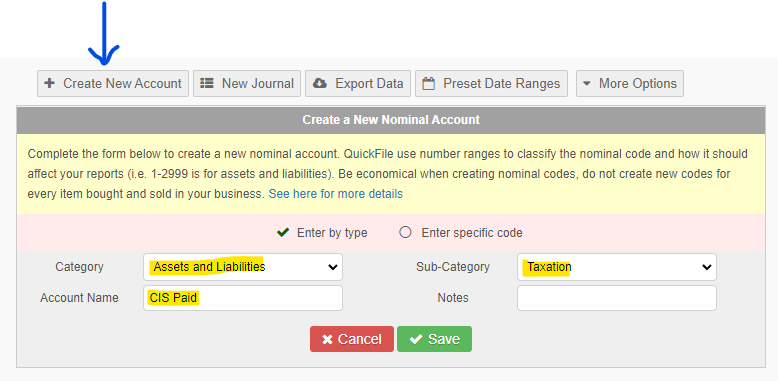CIS - Subcontractors
Introduction
This guide explains how to enter your transactions into QuickFile as a CIS Subcontractor.
If you invoice a client who is registered under the Construction Industry Scheme (CIS) as a Contractor, then you would always invoice them as normal for the full value of the work done.
When you receive payment, this will typically be 20% or 30% less than the invoiced value, depending if you are registered with HMRC as a CIS Subcontractor. This guide will explain in detail how to account for the difference.
1. Create a bank account
The first thing you will need to do is create a bank account, this is not a regular bank account, but a type of “virtual account” that we can use to track the differences in the invoice amounts and payments received.
In the bank management section click the green button at the top of the page “Create Bank Account”.
Now complete the form as follows, no need to provide an account number or sort code.
2. Create your invoice
This is the easy bit, just create your invoice as you would normally for the full value of the work done. No need to worry about any deductions. Just remember to itemise the separate amounts for labour and materials to help your client work out the appropriate CIS deductions.
For the purpose of this guide we will assume the full amount of the invoice is £500 and purely for labour costs (which would be subject to CIS deductions).
3. Recording payments
OK so the invoice has been issued and your client has paid you the NET sum of £400 (£500 less a 20% CIS deduction). Now what we would do is mark the original invoice as paid “in full”.
Instead of paying the invoice to your regular bank account, you would instead pay the full amount to the CIS Deductions account (your virtual bank account for tracking CIS).
On your main business account you will eventually see the NET payment received from your client, in this case that would be £400. Simply tag this payment as a “Bank Transfer” to the “CIS Deductions” account.

4. Recording the tax paid
You CIS Deductions account should now look like this:
As you will see there’s a £100 credit on this account, that’s the equivalent of the CIS Deduction made by your contractor and paid to HMRC.
To balance out the account enter a £100 “money out” entry on the CIS Deductions account.
Now we need to head over to the Chart of Accounts area by going to the top menu option “Reports” followed by “Chart of Accounts”. Click the button at the top to “Create New Account”. Now complete as follows:
This is a balance sheet code that we can tag those balancing payments to in the CIS Deductions account, it will allow us to easily see what CIS deductions were made over a given period.
Now return to the CIS Deductions bank account, click to tag the £100 entry and select “Something else not on the list” and tag the payment directly to the “CIS Paid” nominal account.

All 3 entries relating to this transaction should now be tagged on the CIS Deductions account.
5. Completing your Self Assessment Tax Return (Sole Traders)
If you are a sole trader you will need to ensure that you are not taxed twice on your existing CIS deductions, you would need to enter the total of any deductions for the accounting period on your self assessment tax return form. For the shorthand version that would be box 38, and if you’re using the long hand version it’s box 81.
You can easily query the “CIS Paid” nominal account mentioned in the last step to see all your deductions for a given period.
Find out more about CIS here:
HMRC Guide: What you must do as a Construction Industry Scheme (CIS) subcontractor







